Arp 220 is an ultraluminous starburst galaxy located 250 million light years away in the constellation Serpens. The galaxy is the product of a collision of two smaller galaxies. The merger remnant has an apparent magnitude of 13.9 and an apparent size of 1.5 by 1.2 arcminutes, corresponding to a diameter of 110,000 light-years. The galaxy is listed as IC 1127 and IC 4553 in the Index Catalogue.
Arp 220 is the nearest ultraluminous infrared galaxy (ULIRG) to Earth. As the closest such galaxy, it is considered to be a prototypical ULIRG and is frequently a target of study. Based on observations with the Chandra X-ray Observatory and the XMM-Newton satellite, the galaxy is believed to have an active galactic nucleus (AGN). The AGN is powered by a supermassive black hole at the galaxy’s core, which may be a product of the galactic collision. The nucleus is heavily obscured by dust.
Arp 220 really contains two supermassive black holes, about 1,200 light-years apart. The two compact, highly obscured nuclei once belonged to the two smaller galaxies that merged to form a single larger one. The western nucleus is believed to be active. The dual nuclei were revealed by observations with the Hubble Space Telescope (HST) at infrared wavelengths.
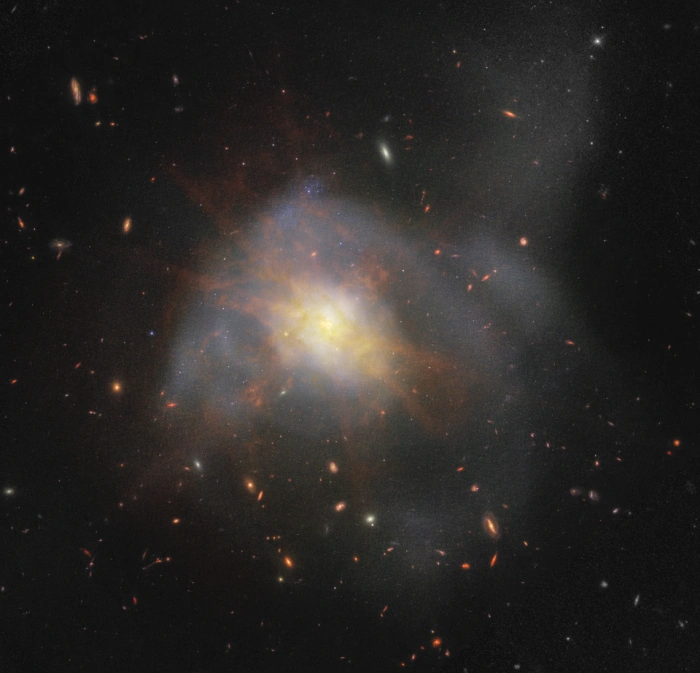
A combination of JWST and HST data showing a new view of ultraluminous infrared galaxy Arp 220, image credit: Judy Schmidt (CC BY 2.0)
Each galactic core is surrounded by a rotating ring in which star formation is taking place. The rings were captured by the James Webb Space Telescope (JWST) in the infrared in 2023. Webb’s infrared eye has also revealed faint tidal tails formed of material pulled out of the merging galaxies by gravitational forces.
A 2024 study resolved two counter-rotating disks around the nuclei, embedded within larger rotational disks. Using the NIRSpec instrument aboard the James Webb telescope, astronomers found evidence of molecular, ionized and neutral outflows associated with the two nuclei. The outflows have velocities of up to 1,000 km s-1. The study authors found a total outflow mass of 107 M⊙.
The galaxy’s high energy output in the infrared is believed to be the result of a massive wave of star forming activity. The starburst was triggered by the close interaction of the two merging galaxies.
The nuclear disks are the only starburst sites in Arp 220. A 2023 study based on observations with Hubble found little evidence for massive clusters with an estimated age of less than 100 million years anywhere in the galaxy. The study authors proposed that star formation has shut down everywhere except in the nuclear rings.
Based on the ages and masses of the detected star clusters, the team found that star formation took place continuously with a rate of 3 – 12 solar masses per year starting a few billion years ago until 100 million years ago. With the exception of the central rings, the galaxy appears to be in a post-starburst state.
The two smaller galaxies that form Arp 220 started merging approximately 700 million years ago. The star formation triggered by the collision has produced around 200 large star clusters in an area 5,000 light years across. The region in which these clusters reside contains as much gas as the entire Milky Way galaxy.
Ultraluminous infrared galaxies are characterized by luminosities above 1012 solar luminosities. These galaxies appear more luminous at infrared wavelengths than at all other wavelengths combined. Many of them are in the process of interacting with other galaxies. The high luminosity comes from the high rate of star formation, triggered by interactions, disruptions and collisions. ULIRGs can produce as many as 100 new stars per year. In comparison, our own Milky Way galaxy creates about one star a year.
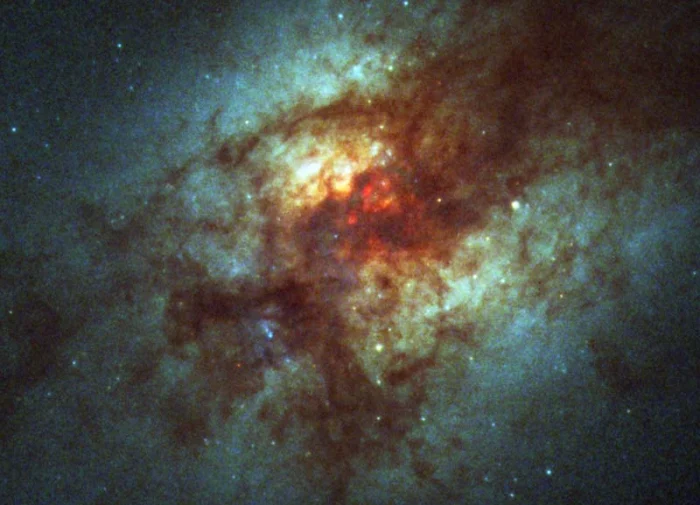
Galaxy Arp 220 as imaged by the Wide Field Planetary Camera on the Hubble Space Telescope, credit: NASA, ESA, and C. Wilson (McMaster University, Hamilton, Ontario, Canada) (PD)
ULIRGs are believed by some to be the product of galactic mergers. As the mergers progress, the galaxies become more luminous. Simultaneously, their central black holes are fed by infalling gas. Once the active nuclei run out of fuel, the luminosity decreases. When the black holes are no longer active, the product of the collision becomes an elliptical galaxy.
Arp 220 hosted a record-breaking seven supernovae, all discovered at the same time. The discovery was reported by a team led by Fabien Batejat, a Ph. D. student at Chalmers University, Onsala, Sweden, in 2011.
The supernovae were detected during a 17-year monitoring of radio sources in the galaxy using 57 of the largest radio telescopes across two continents. The supernovae are less than 1 light year across, corresponding to an angular size of less than 0.5 milliarcseconds. The progenitors of the seven supernovae all went out at around the same time. In comparison, the entire Milky Way galaxy hosts a single supernova event every 100 hundred years.
In 2017, observations of Arp 220 with radio telescopes have revealed a total of around 100 supernova remnants in a region less than 500 light years across.
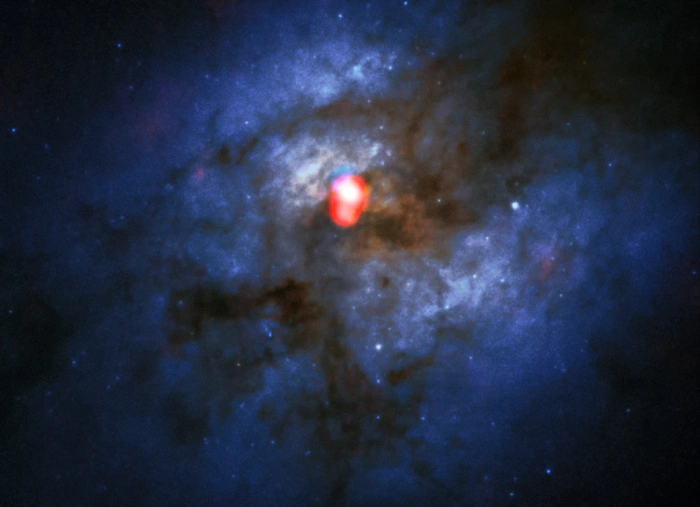
The compound view shows a new ALMA Band 5 image of the colliding galaxy system Arp 220 (in red) on top of an image from the NASA/ESA Hubble Space Telescope (blue/green). With the newly installed Band 5 receivers, ALMA has now opened its eyes to a whole new section of this radio spectrum, creating exciting new observational possibilities and improving the telescope’s ability to search for water in the Universe. In the Hubble image, most of the light from this dramatic merging galaxy pair is hidden behind dark clouds of dust. ALMA’s observations in Band 5 show a completely different view. Here, Arp 220’s famous double nucleus, invisible for Hubble, is by far the brightest feature in the whole galaxy complex. In this dense, double centre, the bright emission from water and other molecules revealed by the new Band 5 receivers will give astronomers new insights into star formation and other processes in this extreme environment. This image is one of the first taken using Band 5 and was intended to verify the scientific capability of the new receivers. The ALMA image includes data recording emission from water, CS and HCN in the galaxies. Credit: ALMA(ESO/NAOJ/NRAO)/NASA/ESA and The Hubble Heritage Team (STScI/AURA) (CC BY 4.0)
Facts
Arp 220 was discovered by American astronomer and mathematician Truman Safford on May 4, 1866. Safford’s discovery led to the galaxy being listed as IC 1127 in the Index Catalogue.
French astronomer Stéphane Javelle discovered the galaxy independently on July 25, 1903, which led to it being catalogued as IC 4553. Javelle provided a more accurate position for the object, which is what led to the double entry.
Arp 220 was observed by the Hubble Space Telescope (HST) in 1997 and 2002. Images obtained with Hubble’s Advanced Camera for Surveys (ACS) in visible light and the Near Infrared Camera and Multi-Object Spectrometer (NICMOS) in the infrared revealed over 200 massive star clusters in the central region of the merger remnant. Some of these huge star clusters have masses equal to around 10 million Suns.
In 2008, astronomers reported detecting organic molecules – methanimine and hydrogen cyanide – in the galaxy using the radio telescope at Arecibo Observatory in Puerto Rico. These compounds are ingredients that form amino acids. Combined with water, they form glycine.
Arp 220 was also found to contain an OH megamaser and a water maser.
American astronomer Halton Arp included the interacting galaxies as the 220th object in his Atlas of Peculiar Galaxies, published by the California Institute of Technology (Caltech) in 1966. Arp objects numbered 146 through 268 are galaxies with neither spiral nor elliptical shapes.
Arp 220 was discovered to be exceptionally luminous in the infrared by the Infrared Astronomical Satellite (IRAS) in the early 1980s. In 1984, observations with IRAS revealed that the galaxy’s energy output was dominated by the far-infrared part of the spectrum.
The galaxy’s double nucleus was first resolved with the 200-inch Hale telescope at Palomar Observatory in 1989. A team of astronomers at the California Institute of Technology reported the detection of two active nuclei with circumnuclear starbursts at a separation of 0.95 arcseconds. The study was published in The Astrophysical Journal in May 1990.
Location
Arp 220 is located in the equatorial constellation of Serpens, near the border with Corona Borealis (the Northern Crown). It appears in the region between the triangle of stars that form the Serpent’s head and the conspicuous semi-circle of Corona Borealis. The merger remnant lies close to the midpoint of the imaginary line connecting Kornephoros, the brightest star in Hercules, and Izar in Boötes (the Herdsman).
With an apparent magnitude of 13.9, the galaxy is a challenging target for small and medium telescopes. At declination +23° 30’, it is visible from locations north of the latitude 66° S.
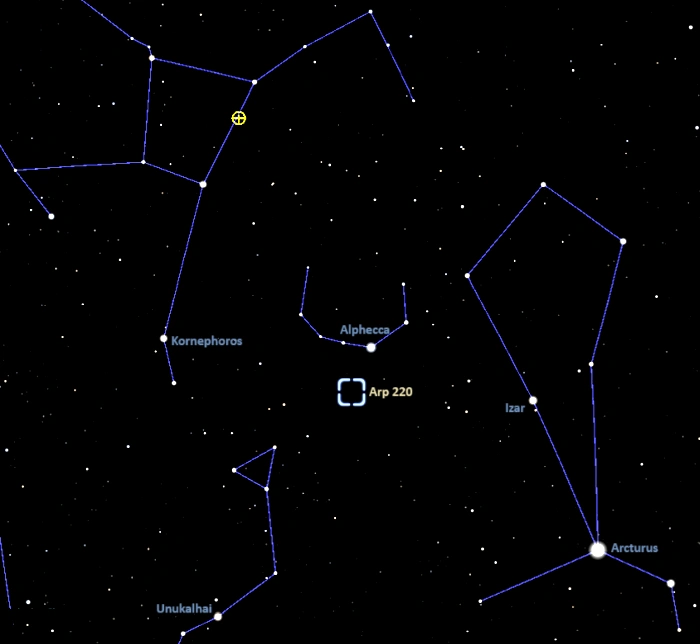
The location of Arp 220, image: Stellarium
Arp 220
| Constellation | Serpens |
| Object type | Merging galaxies |
| Morphological type | S? or SAd |
| Right ascension | 15h 34m 57.1s |
| Declination | +23° 30′ 11″ |
| Apparent magnitude | 13.9 |
| Apparent size | 1.5’ x 1.2’ |
| Distance | 250 million light-years (76.65 megaparsecs) |
| Redshift | 0.018101 |
| Heliocentric radial velocity | 5,377 km/s |
| Size | 110,000 light-years (33,700 parsecs) |
| Names and designations | Arp 220, APG 220, IC 1127, IC 4553, LEDA 55497, PGC 55497, UGC 9913, MCG+04-37-005, SDSS J153457.20+233013.2, AKARI-IRC-V1 J1534572+233011, VV 540, WB 1532+2339, BWE 1532+2339, ECO 11597, Z 136-17, Z 1532.8+2340, WISE J153457.25+233011.5, WISEA J153457.24+233011.4, 2XMM J153457.3+233011, 7C 153246.8+233951, FIRST J153457.2+233011, GB6 J1534+2330, GB6 B1532+2340, KPG 470b, IRAS 15327+2340, IRAS F15327+2340, 2MASX J15345727+2330104, LDC 1130 J153457.27+2330104, MITG J153458+2330, FASHI J153455.59+233013.2, JVAS B1532+236, JVAS J1534+2330, 87GB 153247.1+233949, GLEAM J153456+233020, RFC J1534+2330, JCMTSE J153457.4+233013, JCMTSF J153457.4+233013, TXS 1532+236, NVSS J153457+233011, PSCz Q15327+2340, TGSSADR J153457.3+233011, UZC J153457.4+233011 |
Images
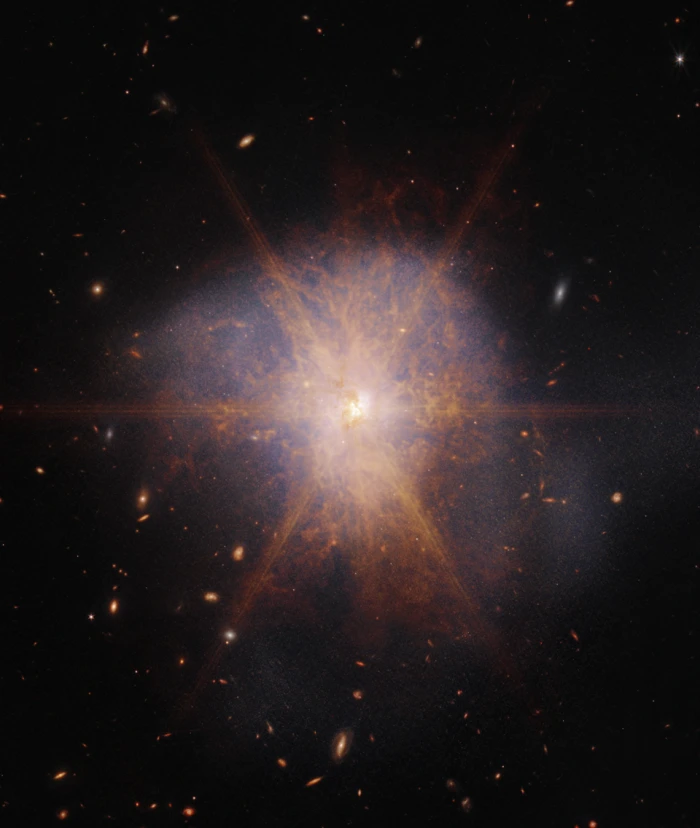
Shining like a brilliant beacon amidst a sea of galaxies, Arp 220 lights up the night sky in this view from the NASA/ESA/CSA James Webb Space Telescope. Actually two spiral galaxies in the process of merging, Arp 220 glows brightest in infrared light, making it an ideal target for Webb. It is an ultra-luminous infrared galaxy (ULIRG) with a luminosity of more than a trillion suns. In comparison, our Milky Way galaxy has a much more modest luminosity of about ten billion suns. It is the nearest ULIRG and the brightest of the three galactic mergers closest to Earth.The collision of the two spiral galaxies began about 700 million years ago. It sparked an enormous burst of star formation. Credit: NASA, ESA, CSA, K. Pontoppidan (STScI), A. Pagan (STScI) (CC BY 4.0)
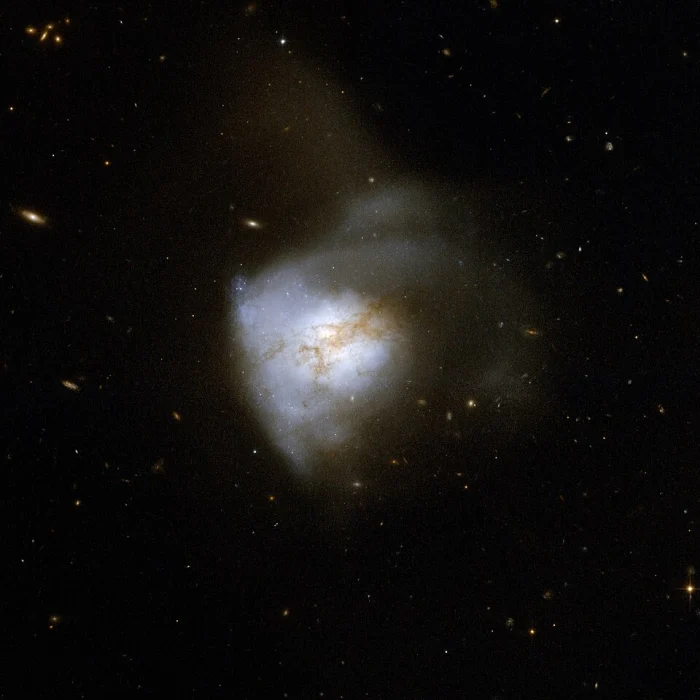
Arp 220 appears to be a single, odd-looking galaxy, but is in fact a nearby example of the aftermath of a collision between two spiral galaxies. This image is part of a large collection of 59 images of merging galaxies taken by the Hubble Space Telescope and released on the occasion of its 18th anniversary on 24th April 2008. Credit: NASA, ESA, the Hubble Heritage (STScI/AURA)-ESA/Hubble Collaboration, and A. Evans (University of Virginia, Charlottesville/NRAO/Stony Brook University) (PD)
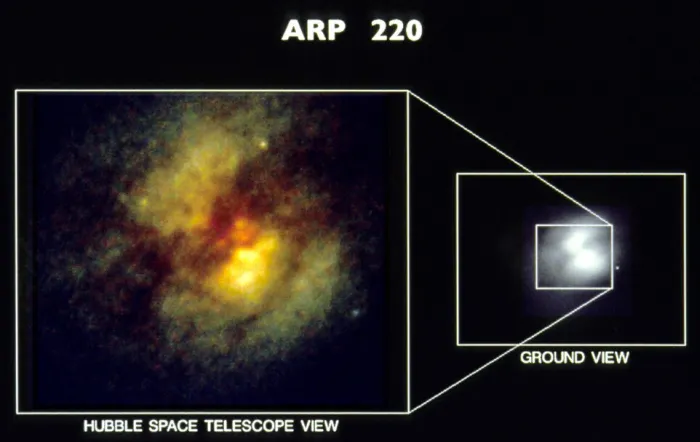
A ground-based telescopic photograph of the peculiar galaxy Arp 220 (image taken by K. Borne, H. Levison, and R. Lucas at USNO Flagstaff Station, Arizona) shows a curious double-lobed structure. This structure was first interpreted as two galaxies merging together, until subsequent observations with highly sensitive CCD detectors revealed a dust lane down the center which made the galaxy appear double lobed. Image: E. Shaya, D. Dowling/U. of Maryland, the WFPC Team, and NASA (PD)
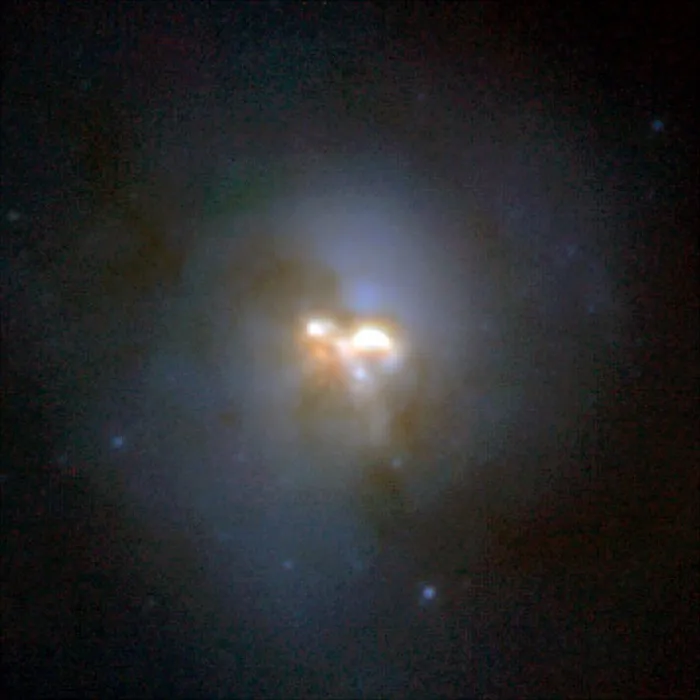
The Hubble Space Telescope’s Near Infrared Camera and Multi-Object Spectrometer (NICMOS) has uncovered a collision between two spiral galaxies in the heart of the peculiar galaxy called Arp 220. The collision has provided the spark for a burst of star formation. The NICMOS image captures bright knots of stars forming in the heart of Arp 220. The bright, crescent moon-shaped object is a remnant core of one of the colliding galaxies. The core is a cluster of 1 billion stars. The core’s half-moon shape suggests that its bottom half is obscured by a disk of dust about 300 light-years across. This disk is embedded in the core and may be swirling around a black hole. The core of the other colliding galaxy is the bright round object to the left of the crescent moon-shaped object. Both cores are about 1,200 light-years apart and are orbiting each other. Arp 220, located 250 million light-years away in the constellation Serpens, is the 220th object in Halton Arp’s Atlas of Peculiar Galaxies. The image was taken with three filters. The colors have been adjusted so that, in this infrared image, blue corresponds to shorter wavelengths, red to longer wavelengths. Credit: NASA/ESA and Hubble (PD)
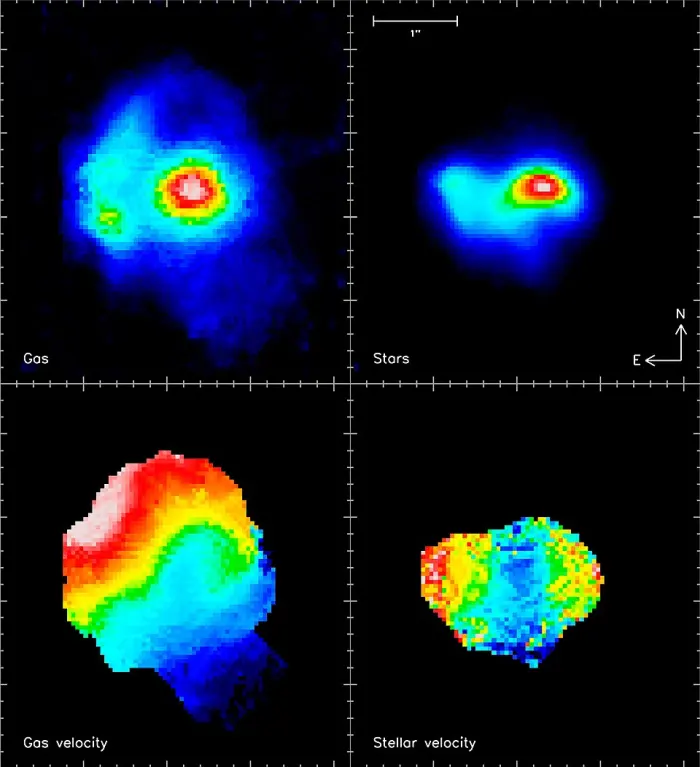
In this galaxy the nuclei are much closer and cannot be distinguished without high spatial resolution. This was a challenging galaxy to observe because it is very difficult to perform the corrections. Nevertheless, a resolution comparable to the Hubble Space Telescope was achieved, i.e. 0.2 second of arc. It reveals for the first time the motion of the stars in this system, showing that there are two counter-rotating discs of stars. These are the nuclei of the progenitor galaxies. In contrast, the motion of the gas is dominated by a larger scale disc, formed from the leftover gas in the discs of the progenitors. The rotation of this gas is governed by the geometry of the interaction, and so is different to that of the stars in the progenitor nuclei. The four images show (from left to right and from top to bottom) : the distribution of the molecular gas, the stellar light, the velocity of the gas, and the velocity of the stars. For the velocity maps, the blue and red colours indicate motion towards us and away from us respectively. Credit: European Southern Observatory (ESO) (CC BY 4.0)
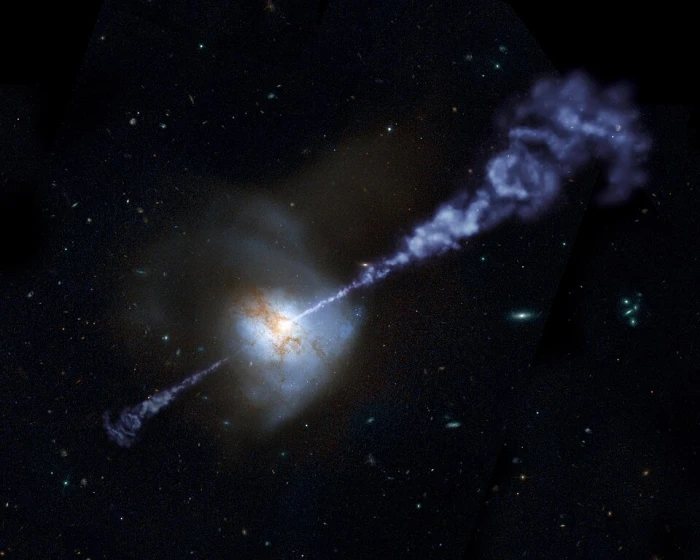
Data obtained with the Herschel Space Observatory shows that galaxies with the most powerful, active, supermassive black holes at their cores produce fewer stars than galaxies with lesser ones. This artist concept of the local galaxy Arp 220, captured by the Hubble Space Telescope, helps illustrate the Herschel results. The bright core of the galaxy, paired with an overlaid artist’s impression of jets emanating from it, indicate that the central black hole’s activity is intensifying. As the active black hole continues to rev up, the rate of star formation will, in turn, be suppressed in the galaxy. Astronomers want to further study how star formation and black hole activity are intertwined. Image credit: NASA (PD)